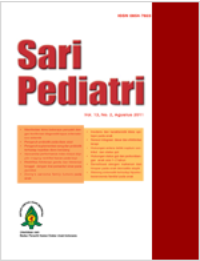Prediktor Keberhasilan Ekstubasi pada Bayi dan Anak
Sari
Indikasi primer untuk melakukan ekstubasi adalah penyembuhan proses primer yang
membutuhkan pipa endotrakeal ( ETT ). Faktor – faktor yang mempengaruhi keberhasilan
ekstubasi seperti stabilitas paru, kardiovaskular, sistim saraf pusat dan metabolik. Sejumlah
pengukuran seperti kadar oksigen, lamanya pemakaian ventilasi, setting ventilasi, termasuk
tekanan tahanan nafas, rasio frekuensi nafas dengan volume tidal (RSBI = rapid swallow breathing
index) dan indeks CROP (compliance, rate, oxygenation and pressure ), dapat dipakai untuk
memprediksi keberhasilan ekstubasi pada anak. Hal lain yang mempengaruhi keberhasilan
ekstubasi adalah faktor teknik atau nonfisiologi yang terdiri dari persiapan ekstubasi, teknik
ekstubasi dan monitoring setelah ekstubasi. Berbagai prediktor yang digunakan untuk
memprediksi keberhasilan ekstubasi tidak menjamin seluruh keberhasilan ekstubasi. Akurasi
dari prediktor ekstubasi sulit diprediksi karena banyak faktor yang menentukan kemampuan
pasien untuk bernafas secara spontan, sehingga diperlukan keterampilan dan ketelitian seorang
dokter dalam melakukan ekstubasi agar berhasil dengan baik.
Kata Kunci
Teks Lengkap:
PDFReferensi
Thiagarajan RR, Bratton SL, martin LD, Brogan TV,
Taylor D. Predictors of successful extubation in children.
Am J Respir Crit Care Med 1999; 160:1562- 6.
Khan N, Brown A, Venkataraman TS. Predictors of extubation
success and failure in mechanically ventilated infants
and children. Crit Care Med 1996; 24:1568-79 .
Parker MM. Predicting success of extubation in children.
Crit Care Med 1996; 24:1429-30.
Morriss FC, Brown OE, Manning SC, Wade B. Extubation
and fiberoptic examination. Dalam: Daniel LL, Frances
CM, penyunting. Essentials of Pediatric Intensive Care.
Louis Missouri: Quality Medical Publ Inc, 1990. h. 945-7.
Morriss CF, Carew J. Extubation. Dalam: Daniel LL, Frances
CM, Gerald CM, penyunting. A Practical Guide to Pediatric
Intensive Care. Toronto: Mosby, 1979. h. 423-5.
Hyzy CR, Popovich J. Mechanical Ventilation and weaning.
Dalam: Carlson WR, Geheb AM, penyunting. Principles
& Parctice of Medical Intensive Care. Philadephia:
Wb Saunders, 1999. h. 924-42.
Zuckerber LA, Nichols GD. Airway Management.
Dalam: Rogers CM, Helfaer AM, penyumting. Handbook
of Pediatric Intensive care. Edisi ke-3. USA: Williams
& Wilkins, 1999. h. 74-6.
Fox WW, Schwartz GJ, Shaffer HT. Successful extubation
of neonates: clinical and physiological factors. Crit
Care Medicine 1981; 9:823-6.
Dartmouth Hitchcock Medical Center: Lebanon. Rapid
extubation protocol. 2000. Didapat dari: URL:
http:www/repiratory care/ct-icu/weaning protocol.htm
Spitzer AR, Fox WW. Positive pressure ventilation : pressure
limited and time cycle ventilators. Dalam: Goldsmith
JP, Karotkin EH, penyunting. Assisted Ventilation
of neonate. Edisi Ketiga. Philadelphia: Saunders,
h. 167-86.
Venkataraman St, Khan N, Brown A, Validation of predictors
of extubation success and failure in mechanically
ventilated infants and children (Article Reviewed).
Crit Care med. 2000; 28:2991-6.
Hubble CL, Gentile MSA, Tripp DS, Craig DM, Meliones
JN, Cheifetz IM. Deadspace to tidal volume ratio predicts
successful extubation in infants and children (Article Reviewed).
Crit Care Med 2000; 28: 2034-40.
Farias JA, Alia I, Esteban A Golibicki, Olazarri FA.
Weaning from mechanical ventilation in pediatric intensive
care patients (Article Reviewed). Intensive Care
Med. 1998; 24:1070-5.
National Guideline Clearinghouse. Removal of the endotracheal
tube (Brief Summary). 1999. Didapat dari : URL:
http:www/guideline-gov/views/summary up guideline htm.
Baumeister BL, El-Khatib M, Smith PG, Blumer JL.
Evaluation of predictors of weaning from mechanical
ventilation in pediatric patients. (Article Reviewed). Pediatric
Pulmonol. 1997; 24:344-52.
Spitzer AR. Mechanical Ventilation. Dalam: Spitzer AR,
edition Intensive Care of the fetus and neonate. USA:
Mosby, 1996. h. 553-70.
Anene O, Meert KL, Uy H, Simpson P, Sarniak AP,
Dexamethasone for the prevention of postextubation
airway obstruction : a prospective, randomized, doubleblind,
placebo-controlled trial (Article Reviewed).Crit
Care Med 1996; 24:1666-9.
Shapiro BA, Harrison RH, Trout CA. Maintenance of
artificial airways and extubation. Dalam: Clinical Application
of Respiratory Care. Chicago: Medical Publ,
h. 261-79.
American University of Beirut. Extubation. 2000.
Didapat dari : URL: http:www/Extubation/ policies and
procedures.htm.
National Institutes of Health. SOP: Patients Requiring
Ventilatory Assistance 1999. Didapat dari : URL:
http:www/sop/ventass/national institutes of health htm
Endotracheal Tube Removal Working Group. AARC
Clinical Practice Guideline Removal of the Endotracheal
Tube. 1999. Didapat dari : URL: http:www/rejournal.com/
online-resource/cpgs/retectepg ht.
DOI: http://dx.doi.org/10.14238/sp5.3.2003.117-21
Refbacks
- Saat ini tidak ada refbacks.
##submission.copyrightStatement##
##submission.license.cc.by-nc-sa4.footer##
Email: editorial [at] saripediatri.org


Sari Pediatri diterbitkan oleh Badan Penerbit Ikatan Dokter Anak Indonesia
Ciptaan disebarluaskan di bawah Lisensi Creative Commons Atribusi-NonKomersial-BerbagiSerupa 4.0 Internasional.




